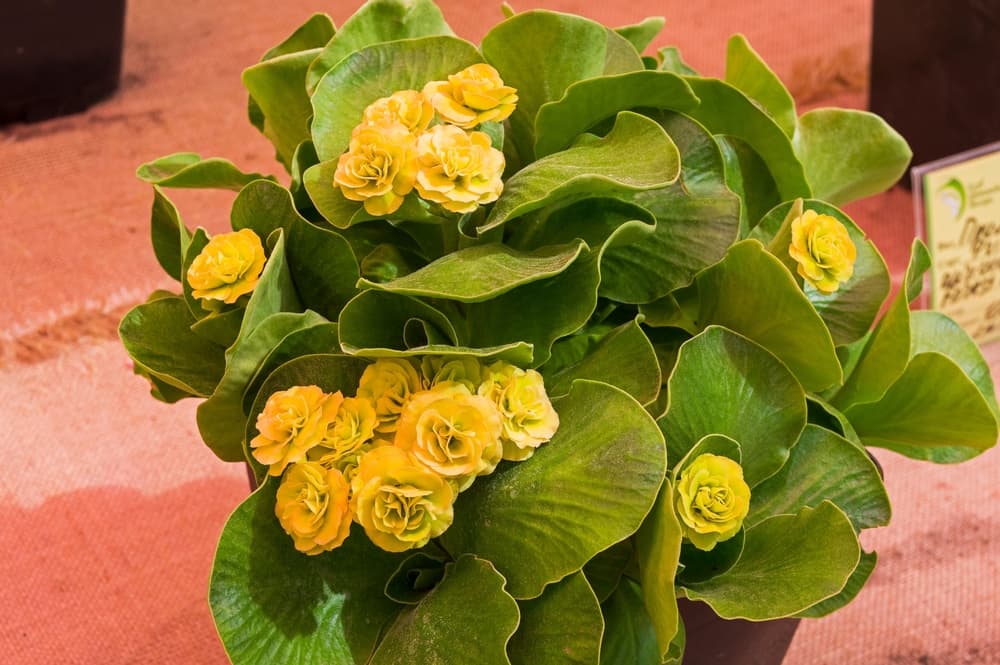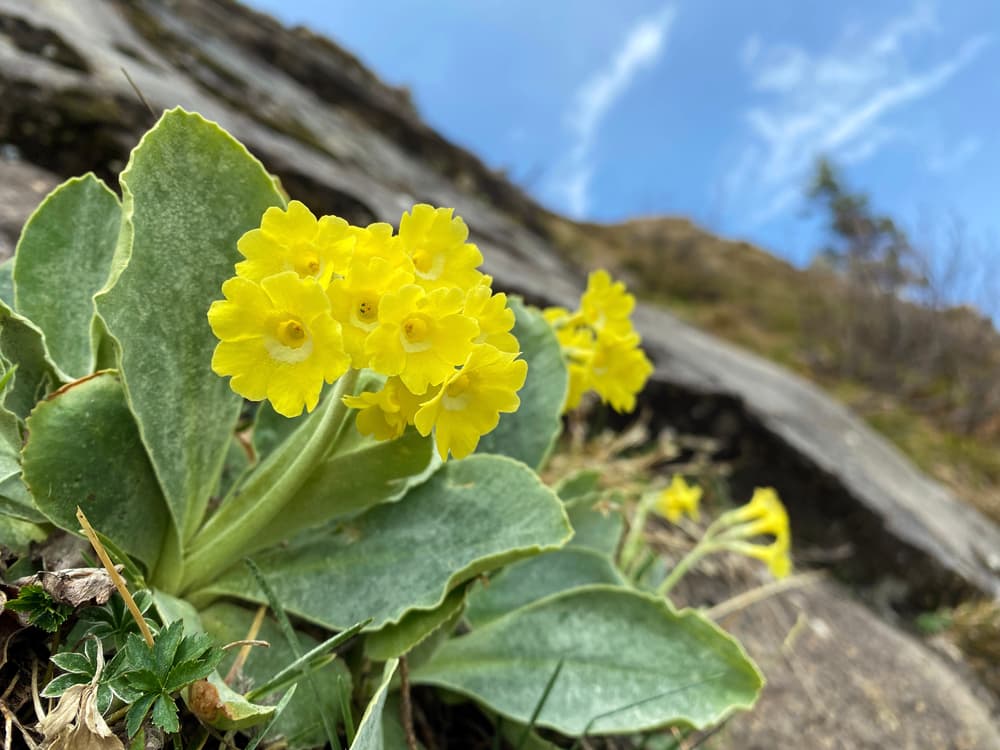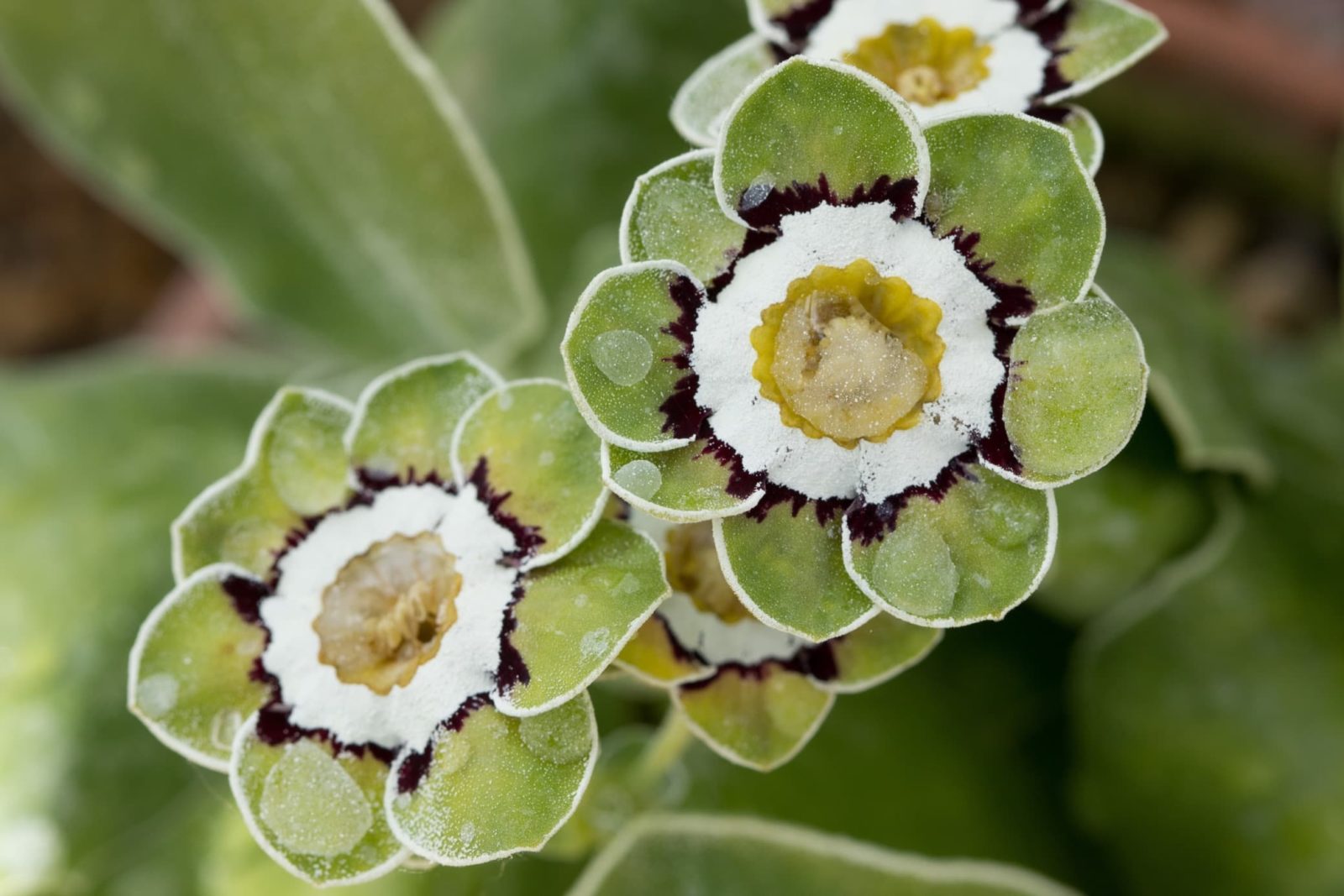PERENNIALS > AURICULA > VARIETIES
Reviewed By COLIN SKELLY

Colin is a Horticulturist and Horticultural Consultant with experience in a range of practical and managerial roles across heritage, commercial and public horticulture. He holds the Royal Horticultural Society’s Master of Horticulture award and has a particular interest in horticultural ecology and naturalistic planting for habitat and climate resilience.
IN THIS GUIDE
- Varieties Explained
- 1) P. auricula
- 2) P. × pubescens
- 3) P. ‘Eden Goldfinch’
- 4) P. auricula ‘Lucy Locket’
- 5) P. auricula ‘Piers Telford’
- 6) P. auricula hort. ‘Joyce’
- 7) P. auricula ‘Piglet’
- 8) P. auricula ‘Golden Hind’
- 9) P. auricula ‘Red Gauntlet’
- 10) P. auricula ‘Remus’
- 11) P. auricula ‘Benny Green’
- 12) P. auricula ‘Maggie’
- 13) P. ‘Pinstripe’
- 14) P. auricula ‘Blush Baby’
- 15) P. auricula hort. ‘Monet’
- 16) P. auricula ‘Nantenan’
- References
AURICULA GUIDES
Varieties
The vernacular word ‘Auricula’ is an umbrella term that encompasses (plants in) Genus Primula, the hybrids developed by crossing Primula auricula and Primula hirsuta – and the innumerable cultivars developed from them.
These plants belong to Family Primulaceae, or the Primrose Family.1The BRAHMS Project, University of Oxford, Department of Plant Sciences. (n.d.-b). Primula auricula. Oxford University Plants. Retrieved March 10, 2023, from https://herbaria.plants.ox.ac.uk/bol/plants400/Profiles/OP/Primulaa
Genus Primula has approximately 521 confirmed or accepted species.2Primula. (n.d.-b). Kew Royal Botanic Gardens. Retrieved April 17, 2023, from https://powo.science.kew.org/taxon/urn:lsid:ipni.org:names:30005261-2#children

Auricula hybrids and cultivars number in the few thousands.3Auricula cultivation. (n.d.). NAPS. Retrieved March 10, 2023, from https://www.southernauriculaprimula.org/auriculas
Species, hybrids or cultivars – these plants are herbaceous, evergreen perennials.
“I love an Auricula display but have always been a bit wary of starting with one and ending up with a greenhouse full!” shares Colin Skelly, Master Horticulturist.
“That said, I have been tempted over the years at flower shows and have five different types and make a mini-display by my front door when they’re in flower.
“Even with a small number, Auriculas make a cheerful display indoors or out in late spring or early summer.”
Varieties Explained
As highly-cultivated plants that bear show flowers, Auricula varieties are divided and sub-divided into types and sub-types with highly-specific inclusions and exclusions of characteristics primarily related to pattern and secondarily to colouration.
The vast majority of cultivar plants are of clump-forming habits and are from 20-40cm tall.

They have a short but spectacular flowering season for only about two months in spring with May being the happiest month.
The strongest types and most trouble-free to grow are Border Auriculas or Garden Auriculas.
These have a white or cream-gold central disk (without farina) with the petals being in a single, though not necessarily solid, colour.
Alpine Types
These are show flowers and are subject to rigorous specifications and restrictions.
Specialists sub-divide them further into Light Centred, Gold Centred, and Laced.

The corolla is sharply gradated from a darker hue near the centre to a lighter one at the rim.
These types do not have any farina or meal on flower or foliage.
Show Types
The specifications and restrictions go double for Show Auriculas, which are subdivided into Self, Edged, Striped, and Fancy sub-types.
Self Shows have a white or creamy farina with the petals in a solid, even-toned colour.

Edged Shows display reduced ground colour in the form of a feathered ring between the disk and the edge, which is usually green and is more like a band than a mere ‘edge’.
Striped Shows have distinct radial striping, be it streaks, stripes or bands, from disk to rim.
Finally, Fancy Shows are a basket class without highly specific restrictions into which any show type that does not fall into the three rigorously-described sub-types may be placed.
Double Types

Finally, Double Auriculas are those with two or more rows of folded and ruffled petals such that they obscure the central disk.
Underneath we run through a representative sample of Auricula flowers, describing two of each type as we take in a few of our favourites.
1) P. auricula

One of the ‘fundamental’ species and is one of only nine Auriculas to have received the RHS’s Award of Garden Merit.
It bears brilliant yellow 2cm flowers with the typical farinose disk, and with a distinct fragrance.
It has a clump-forming habit and can reach half-a-metre in height.
2) P. × pubescens

Similarly a ‘fundamental’ hybrid and has also been accorded the Award of Garden Merit.
It bears 2cm wide fragrant flowers with white, creamy, or yellow farina and is usually pink or purple in colour, but also white or red.
This plant too has a clump-forming habit and is about 10 centimetres.
3) P. ‘Eden Goldfinch’
Type: Border / Garden
Can hardly be matched for its bright cheeriness; the colours of sunshine are displayed by this variety: a yellow eye is surrounded by a cream-yellow disk progressing to flame-orange feathering into a ground of rich, bright sunshine yellow.
4) P. auricula ‘Lucy Locket’
Type: Border / Garden
Features a flower as sedate and restrained as its name would seem to suggest.
Yellow eyes and a hard white centre may be ‘normal’ but the soft pale ochre ground is a sharp change from the usual brilliant tones.
5) P. auricula ‘Piers Telford’
Type: Alpine
A popular variety with colours that are deep and rich and can add some lovely contrast.
The central disk is a bright yellow adjoining which the petals start from blackish maroon, fade to red, and finish in pale orange.
6) P. auricula hort. ‘Joyce’

Type: Border / Garden
This variety also has contrast and displays intense colouration.
The creamy-coloured disk is adjoined by violet petals that start nearly black, fading to violet, and further fading to a border of medium purple.
7) P. auricula ‘Piglet’
Type: Double
Puts out flowers replete with ruffles and frills that go perfectly with its baby pink colour, ranging from purplish-pink near the centre to pale pink near the border.
The layman could be forgiven for confusing it with a carnation!
8) P. auricula ‘Golden Hind’
Type: Double
Could be called a two-in-one Double as the ruffled petals are bright yellow with crimson to rose daubs at the base of the petals feathering into the yellow, similar to Edged Shows.
Unlike most doubles it has a sweet scent.
9) P. auricula ‘Red Gauntlet’
Type: Self Show
‘Basic’ and stunning: the usual yellow eye is surrounded by a pure white farina which makes for a brilliant contrast with the ground of the deepest, richest, hard red.
10) P. auricula ‘Remus’

Type: Self Show
Has the usual yellow eye and a pure white farina with a ground colour of the deepest, richest, royal purple.
It is simple yet stellar.
11) P. auricula ‘Benny Green’
Type: Edged Show
Virtually a four-colour variety starting off with a bright yellow eye and a creamy white disk.
What ‘makes’ this variety is the extraordinary opposite-colour contrast between the green edge and the rich red-purple ground colour with appealing ‘ink bleeds’ into the edge.
12) P. auricula ‘Maggie’
Type: Edged Show
An exceptional variety because of the absence of green and its ‘classic’ colour scheme.
The eye is a deep yellow.
The white disk is nearly matched by the off-white or grey-white edge in-between which a burgundy-black ground shows heavy and uneven feathering into the edge.
13) P. ‘Pinstripe’
Type: Striped Show
Does not have a very descriptive name.
It has a yellow eye; the pure white disk is surrounded by a very deep purplish-burgundy hue that is streaked and striped with white, which shade predominates at the rim.
14) P. auricula ‘Blush Baby’

Type: Striped Show
This one is for you if you like the white-and-red colour combination.
While it has yellow eyes, the optical ‘hit’ lies in the pure white disk with bright rose-red petals that are brushed with white striping.
15) P. auricula hort. ‘Monet’
Type: Fancy Show
Aptly named because it does remind one of the Impressionist palette and style.
A creamy centre is surrounded by petals that subtly gradate and have gentle shadings between pale yellow and pale pink, with some ‘brushstrokes’ of pale lime green.
16) P. auricula ‘Nantenan’
Type: Fancy Show
Has a prominent yellow eye and white disk outside which the ground colour of bluish-green is interspersed with radial strokes and streaks of yellow that match the eye, and fade and gradate into the ground colour in a gently complementary colour scheme.
References
- 1The BRAHMS Project, University of Oxford, Department of Plant Sciences. (n.d.-b). Primula auricula. Oxford University Plants. Retrieved March 10, 2023, from https://herbaria.plants.ox.ac.uk/bol/plants400/Profiles/OP/Primulaa
- 2Primula. (n.d.-b). Kew Royal Botanic Gardens. Retrieved April 17, 2023, from https://powo.science.kew.org/taxon/urn:lsid:ipni.org:names:30005261-2#children
- 3Auricula cultivation. (n.d.). NAPS. Retrieved March 10, 2023, from https://www.southernauriculaprimula.org/auriculas


